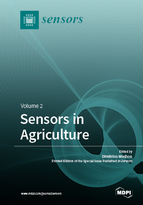Sensors in Agriculture
A special issue of Sensors (ISSN 1424-8220). This special issue belongs to the section "Physical Sensors".
Deadline for manuscript submissions: closed (31 October 2017) | Viewed by 305620
Special Issue Editor
Interests: remote sensing; multiscale fusion robotic agriculture; sensor networks; robotics; development of cognitive abilities; fusion of global and local cognition
Special Issues, Collections and Topics in MDPI journals
Special Issue Information
Dear Colleagues,
Agriculture requires technical solutions for increasing production, while the environmental impact decreases by reduced application of agro-chemicals and increased use of environmental friendly management practices. A benefit of this is the reduction of production costs. Technologies of Sensors produce tools to achieve the above-mentioned goals. The explosive technological advances and development in recent years enormously facilitates the attainment of these objectives by removing many barriers for their implementation, including reservations expressed by farmers themselves. Precision Agriculture is an emerging area, where sensor-based technologies play an important role.
Farmers, researchers, and technical manufacturers, all together, are joining efforts to find efficient solutions and improvements in production and in to reductions in costs. This Special Issue aims to bring together recent research and development concerning novel sensors and their applications in agriculture. Sensors in agriculture are based on the requirements of the farmers according to the farming operations that need to be addressed. Papers addressing sensor development addressing a wide range of agricultural tasks, including, but not limited to, recent research and developments in the following areas are expected:
- Optical sensors: Hyperspectral, Multispectral, Fluorescence and thermal sensing
- Sensors for Crop health status determination
- Sensors for crop phenotyping, germination, emergence and determination of the different growth stages of crops
- Sensors for detection of Microorganisms and Pest management
- Airborne sensors (UAV)
- Multisensor systems, sensor fusion
- Non-destructive soil sensing
- Yield estimation and prediction
- Detection and identification of crops and weeds
- Sensors for detection of fruits
- Sensors for fruit quality determination
- Sensors for Weed Control
- Volatile components detection, and electronic noses and tongues
- Sensors for positioning, navigation, and obstacle detection
- Sensor networks in agriculture, wearable sensors, and Internet of things
- Low energy, disposable and energy harvesting sensors in agriculture
Prof. Dr. Dimitrios Moshou
Guest Editor
Manuscript Submission Information
Manuscripts should be submitted online at www.mdpi.com by registering and logging in to this website. Once you are registered, click here to go to the submission form. Manuscripts can be submitted until the deadline. All submissions that pass pre-check are peer-reviewed. Accepted papers will be published continuously in the journal (as soon as accepted) and will be listed together on the special issue website. Research articles, review articles as well as short communications are invited. For planned papers, a title and short abstract (about 100 words) can be sent to the Editorial Office for announcement on this website.
Submitted manuscripts should not have been published previously, nor be under consideration for publication elsewhere (except conference proceedings papers). All manuscripts are thoroughly refereed through a single-blind peer-review process. A guide for authors and other relevant information for submission of manuscripts is available on the Instructions for Authors page. Sensors is an international peer-reviewed open access semimonthly journal published by MDPI.
Please visit the Instructions for Authors page before submitting a manuscript. The Article Processing Charge (APC) for publication in this open access journal is 2600 CHF (Swiss Francs). Submitted papers should be well formatted and use good English. Authors may use MDPI's English editing service prior to publication or during author revisions.
Keywords
- Agricultural sensors
- Sensor information acquisition
- sensor information processing
- Sensor-based decision making
- sensors in agriculture
- precision agriculture
- sensors in agricultural production
- technologies
- sensors applications
- processing of sensed data







